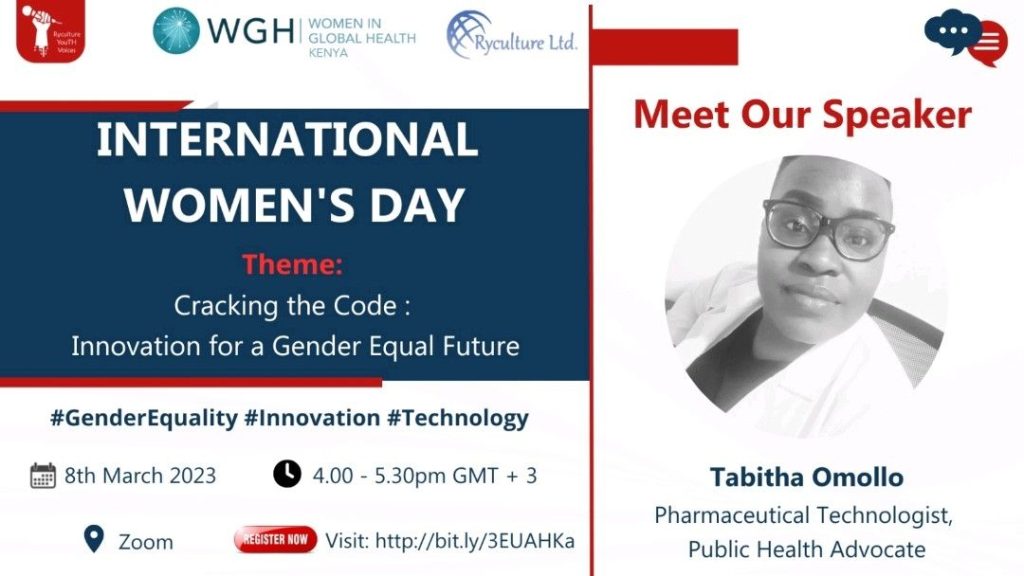Acknowledgement
We acknowledge and appreciate the contributions made by; Dr. Marie-Claire Wangari, Eng. Winnie Kibiru and Tabitha Ooko in championing for and fostering innovation among women.
We also extend our appreciation to the participants who actively engaged throughout the discussions.
Executive Summary
Gender inequality is often propagated in various sectors due to socio-cultural beliefs and social constructs about careers men and women should venture into. The technological sector is one of the sectors that promise transformative change in healthcare, yet with the technological advancements the inclusion of women is conspicuously missing particularly in low-and-middle income countries (LMICs). There is therefore need to advocate for inclusion of women in innovation and technology for a gender equal future. This is necessary as gender responsive approaches in technology brings with it diversity in perspective and expertise for development in global health.
International Women’s Day as observed by the United Nations recognizes the women and girls who are championing the advancement of transformative technology and explores the impact of the digital gender gap on widening economic and social inequalities.[1] Women’s exclusion from the digital world has shaved $1 trillion from the gross domestic product of low- and middle-income countries in the last decade—a loss that will grow to $1.5 trillion by 2025 without action.[2] This serves as a call to action in closing the digital gender gap. In the healthcare space, gender inequality is not only evident in the technological advances but even in healthcare leadership where women account for 70% of healthcare workforce but led by men.[3]
Taking into account the digital gender gap that exists, the International Women’s Day as observed by the United Nations recognizes the women and girls who are championing the advancement of transformative technology and explores the impact of the digital gender gap on widening economic and social inequalities.[4] This year’s theme, DigitALL: Innovation and technology for gender equality speaks to the need to actively have more women empowered to become innovative, embrace technology and advance gender transformative policies for health equity.
Ryculture Health and Social Innovation held a webinar on 8th March to mark International Women’s Day under the theme ‘Cracking the Code: Innovation for a Gender Equal Future. The webinar highlighted youth perspectives in fostering innovation among women and advancing gender equity in health.
The objectives of the day were;
- To deliberate on how innovation can be fostered among women to address healthcare challenges.
- To encourage equal access and involvement of women in technology
- To champion for gender equality
This report captures a summary of the deliberations during the webinar. The recording of the session can be accessed through our YouTube channel here
Discussion
Youth Perspectives in Fostering Innovation for a Gender Equal Future.
Tabitha Ooko’s presentation was guided by the objectives and highlighted her recommendations as a youth on how to foster innovation among women, involvement of women in technology and advocate for gender equality
- Fostering Innovation among Women to Address Healthcare Challenges:
In a bid to foster innovation among women, there’s need to:
- Make innovations core to culture
- Take advantage of emerging technologies
- Consider strategic partnerships and creation of safe spaces for ideas to be shared
- Encourage diversity In the workspace: Means having a workforce inclusive of different backgrounds (inclusive of gender, socioeconomics, cultural diversity and beyond)
- Encouraging Equal Access and Involvement of Women in Technology
Health workforce comprises of 70% of women as healthcare providers. Therefore there is need to:
- Close the tech access and usage gap through programs that motivate women to join. This means coming up with classes and sessions specifically targeting girls and women.
- Create a safe environment in the digital space suitable for women to access and operate.
- Empower women to get involved in creation of digital technology. This will help in recognizing and encouraging women not only as end users but also as developers and creators. This will lead to women practicing and getting more involved in the technology space.
- Have inspiring figures and role models will help attract more women to the field of digital health. As women, we should make intentional effort to make our peers feel welcomed and included in the field and digital health.
- Work and network with communities where women can exchange experiences, knowledge, and opportunities in the field enabling more women to join digital health.
- Championing for Gender Equality
Gender equality can be realized when we make sure that any decision made, opportunities offered or treatment is not based on gender but on ability and capability as enshrined in SDG 5 –gender equality and women empowerment. This includes:
- Ending gender disparity
- Eliminating early and forced marriages
- Securing equal participation and opportunities at work
- Encouraging women leadership and participation in decision making tables.
- Ensuring universal access to sexual and reproductive health and rights
Cracking the Code: Innovation for a Gender Equal Future
Eng. Winnie Kibiru, The Technical Analyst at Villgro Africa focused on business innovation and advancing innovation among women in healthcare. Villgro Africa is an incubator and impact investor supporting start-up/ upcoming healthcare businesses to scale their ideas.
Women in Healthcare and Fostering Innovation
Women are often at the forefront of healthcare in Africa. They are often the first point of contact for healthcare services and therefore have unique insights and experiences that can help identify and recommend innovative solutions to address healthcare issues in Africa.
Most healthcare innovations are built for women but understood by men yet majority of healthcare providers are women. There is therefore need to leverage their knowledge and skills and empowered to create innovative solutions to healthcare problems.
Innovation need not be narrowed down to creating devices but also consider social innovation and research that could address healthcare problems. In order to foster innovation there’s need to
- Establish a collaborative and creative healthcare environment
- Consider solutions that are well thought through, tried and tested and one that understands the product environment and end user. This would encourage investors to invest in the innovations
- Take advantage of emerging technology by researching, networking and collaborating with other innovators
- Fund innovations led by women.
Business Innovation
Once you have an innovative idea in mind, the problem statement and end users are well understood, there is also need to make room for innovation to make business. The following recommendations were provided to realize this.
- Having a concise plan i.e. the problem statement, end users, the proposed solution
- A good team to ensure streamlined delivery of the proposed solutions/product
- Understanding the market of the proposed product/solution
Having a vision and strategy is vital to the success of a business. Similarly, one should be prepared to face setbacks and challenges in the course of implementation and devise ways to address them.
Challenging Power and Privilege for Gender Equity in Health
Dr. Marie Claire courtesy of Women in Global Health (WGH) shared the work undertaken by WGH in advancing gender equity in health as presented in their tagline ‘Challenging power and privilege for gender equity in health’. She affirmed that ideas can grow to become a reality as attested by the formation of WGH after realizing the attendance of women in global health conferences was low. With 55% of WGH chapters being in low and middle income countries, they reach out to those traditionally left out in global dialogue at global, regional and national levels to drive social change through evidence, policy and mobilisation.
Through their efforts of mobilisation, advocacy for change, garnering commitments and holding leaders accountable, the outcomes hoped for and observed have been; gender transformative policies and practices, diverse movement for gender equality in health, safe working conditions for women and equal and diverse representation of women in leadership.
She noted that workplace gender biases, discrimination and inequities are systemic since global health is often delivered by women but led by men. Women in health are often underpaid and often unpaid. Additionally, workplace violence and sexual harassment in health and the social sector are widespread and often hidden.
Moving towards a gender transformative health sector will require addressing the causes of gender based health inequities. It also aims at fostering progressive changes in power relations between genders. Health workforce investments generate significant economic dividends across the SDGs.
Some of the innovative ideas highlighted were; wheels for life an initiative that using telehealth and emergency transport to improve pregnancy outcomes. She challenged us to see how expansion of innovative ideas can move beyond cities to hard to reach areas.
Recommendations
- Leveraging social media or blogs and opinion pieces that highlight how gender equity and importance of technology
- Taking advantage of the hackathon clubs within the universities to incubate innovative ideas
[1] International Women’s Day 2023. DigitALL innovation and technology for gender equality. https://www.unwomen.org/en/news-stories/announcement/2022/12/international-womens-day-2023-digitall-innovation-and-technology-for-gender-equality?
[2] Progress on the sustainable development goals. The Gender snapshot. https://www.unwomen.org/sites/default/files/2022-09/Progress-on-the-sustainable-development-goals-the-gender-snapshot-2022-en_0.pdf
[3] Delivered by women, led by men. https://cdn.who.int/media/docs/default-source/health-workforce/delivered-by-women-led-by-men.pdf?sfvrsn=94be9959_2
[4] International Women’s Day 2023. DigitALL innovation and technology for gender equality. https://www.unwomen.org/en/news-stories/announcement/2022/12/international-womens-day-2023-digitall-innovation-and-technology-for-gender-equality?

